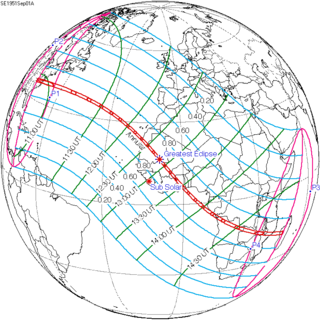| Solar eclipse of September 1, 1951 | |
|---|---|
| Type of eclipse | |
| Nature | Annular |
| Gamma | 0.1557 |
| Magnitude | 0.9747 |
| Maximum eclipse | |
| Duration | 156 s (2 min 36 s) |
| Coordinates | 16°30′N 8°30′W / 16.5°N 8.5°W |
| Max. width of band | 91 km (57 mi) |
| Times (UTC) | |
| Greatest eclipse | 12:51:51 |
| References | |
| Saros | 134 (40 of 71) |
| Catalog # (SE5000) | 9401 |
An annular solar eclipse occurred at the Moon's descending node of orbit on Saturday, September 1, 1951,[1] with a magnitude of 0.9747. A solar eclipse occurs when the Moon passes between Earth and the Sun, thereby totally or partly obscuring the image of the Sun for a viewer on Earth. An annular solar eclipse occurs when the Moon's apparent diameter is smaller than the Sun's, blocking most of the Sun's light and causing the Sun to look like an annulus (ring). An annular eclipse appears as a partial eclipse over a region of the Earth thousands of kilometres wide. Occurring 5.4 days after apogee (on August 27, 1951, at 3:50 UTC), the Moon's apparent diameter was smaller.[2]
Annularity was visible from Tennessee, North Carolina, and Virginia in the United States, Spanish Sahara (today's West Sahara), French West Africa (the parts now belonging to Mauritania, Mali, Burkina Faso and Ivory Coast), British Gold Coast (today's Ghana), southern tip of French Equatorial Africa (the part now belonging to R. Congo), Belgian Congo (today's DR Congo), Northern Rhodesia (today's Zambia), Portuguese Mozambique (today's Mozambique), Nyasaland (today's Malawi), and French Madagascar (today's Madagascar). A partial eclipse was visible for parts of eastern North America, the Caribbean, northern South America, Europe, and Africa.
- ^ "September 1, 1951 Annular Solar Eclipse". timeanddate. Retrieved 5 August 2024.
- ^ "Moon Distances for London, United Kingdom, England". timeanddate. Retrieved 5 August 2024.
